Unit 28: Organic Chemistry Reactions
VerifiedAdded on 2019/09/13
|5
|964
|1045
Practical Assignment
AI Summary
This assignment, part of a BTEC Extended Diploma in Applied Science, focuses on the reactions of functional groups and multistep synthesis in organic chemistry. Students are tasked with creating a leaflet describing reactions of non-carbonyl functional groups (haloalkanes, alcohols, and amines), completing a worksheet predicting products of reactions involving carbonyl compounds, and developing synthesis maps for multi-step reactions to produce target molecules from given starting molecules. The assignment assesses their understanding of organic reaction mechanisms and their ability to plan and execute multi-step syntheses. Resources such as textbooks and online chemistry resources are provided.
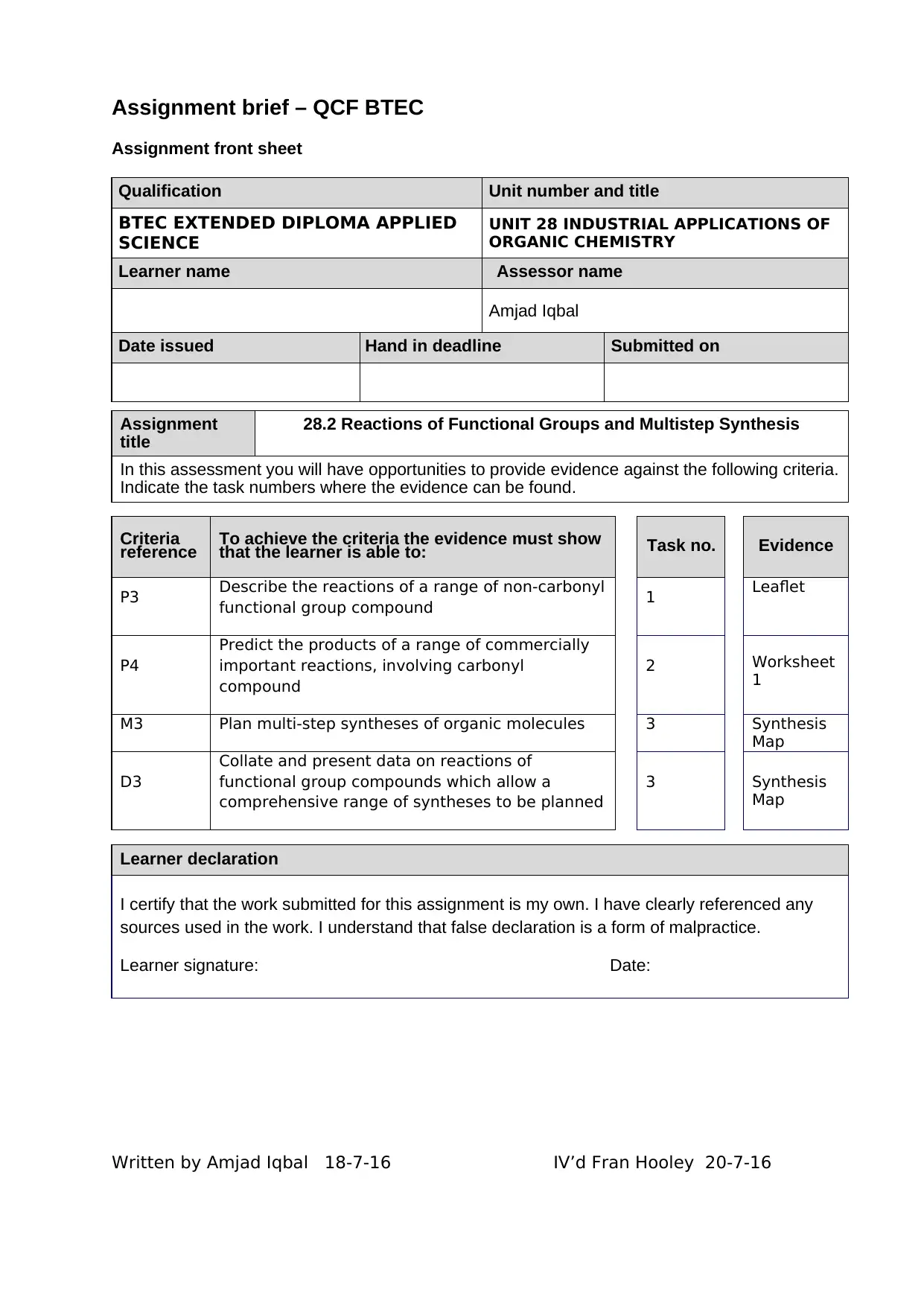
Assignment brief – QCF BTEC
Assignment front sheet
Qualification Unit number and title
BTEC EXTENDED DIPLOMA APPLIED
SCIENCE
UNIT 28 INDUSTRIAL APPLICATIONS OF
ORGANIC CHEMISTRY
Learner name Assessor name
Amjad Iqbal
Date issued Hand in deadline Submitted on
Assignment
title
28.2 Reactions of Functional Groups and Multistep Synthesis
In this assessment you will have opportunities to provide evidence against the following criteria.
Indicate the task numbers where the evidence can be found.
Criteria
reference To achieve the criteria the evidence must show
that the learner is able to: Task no. Evidence
P3 Describe the reactions of a range of non-carbonyl
functional group compound 1 Leaflet
P4
Predict the products of a range of commercially
important reactions, involving carbonyl
compound
2 Worksheet
1
M3 Plan multi-step syntheses of organic molecules 3 Synthesis
Map
D3
Collate and present data on reactions of
functional group compounds which allow a
comprehensive range of syntheses to be planned
3 Synthesis
Map
Learner declaration
I certify that the work submitted for this assignment is my own. I have clearly referenced any
sources used in the work. I understand that false declaration is a form of malpractice.
Learner signature: Date:
Written by Amjad Iqbal 18-7-16 IV’d Fran Hooley 20-7-16
Assignment front sheet
Qualification Unit number and title
BTEC EXTENDED DIPLOMA APPLIED
SCIENCE
UNIT 28 INDUSTRIAL APPLICATIONS OF
ORGANIC CHEMISTRY
Learner name Assessor name
Amjad Iqbal
Date issued Hand in deadline Submitted on
Assignment
title
28.2 Reactions of Functional Groups and Multistep Synthesis
In this assessment you will have opportunities to provide evidence against the following criteria.
Indicate the task numbers where the evidence can be found.
Criteria
reference To achieve the criteria the evidence must show
that the learner is able to: Task no. Evidence
P3 Describe the reactions of a range of non-carbonyl
functional group compound 1 Leaflet
P4
Predict the products of a range of commercially
important reactions, involving carbonyl
compound
2 Worksheet
1
M3 Plan multi-step syntheses of organic molecules 3 Synthesis
Map
D3
Collate and present data on reactions of
functional group compounds which allow a
comprehensive range of syntheses to be planned
3 Synthesis
Map
Learner declaration
I certify that the work submitted for this assignment is my own. I have clearly referenced any
sources used in the work. I understand that false declaration is a form of malpractice.
Learner signature: Date:
Written by Amjad Iqbal 18-7-16 IV’d Fran Hooley 20-7-16
Paraphrase This Document
Need a fresh take? Get an instant paraphrase of this document with our AI Paraphraser
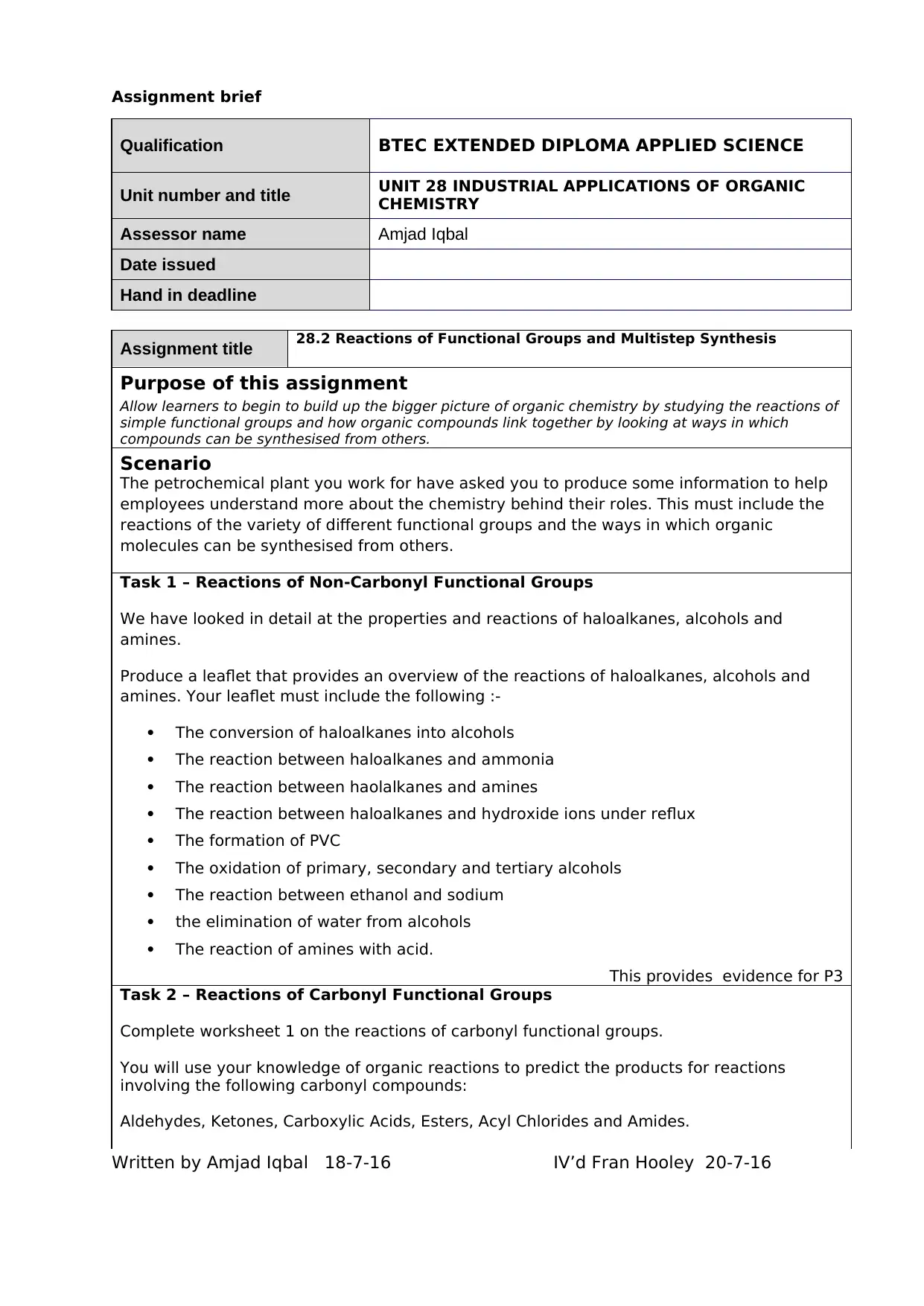
Assignment brief
Qualification BTEC EXTENDED DIPLOMA APPLIED SCIENCE
Unit number and title UNIT 28 INDUSTRIAL APPLICATIONS OF ORGANIC
CHEMISTRY
Assessor name Amjad Iqbal
Date issued
Hand in deadline
Assignment title 28.2 Reactions of Functional Groups and Multistep Synthesis
Purpose of this assignment
Allow learners to begin to build up the bigger picture of organic chemistry by studying the reactions of
simple functional groups and how organic compounds link together by looking at ways in which
compounds can be synthesised from others.
Scenario
The petrochemical plant you work for have asked you to produce some information to help
employees understand more about the chemistry behind their roles. This must include the
reactions of the variety of different functional groups and the ways in which organic
molecules can be synthesised from others.
Task 1 – Reactions of Non-Carbonyl Functional Groups
We have looked in detail at the properties and reactions of haloalkanes, alcohols and
amines.
Produce a leaflet that provides an overview of the reactions of haloalkanes, alcohols and
amines. Your leaflet must include the following :-
The conversion of haloalkanes into alcohols
The reaction between haloalkanes and ammonia
The reaction between haolalkanes and amines
The reaction between haloalkanes and hydroxide ions under reflux
The formation of PVC
The oxidation of primary, secondary and tertiary alcohols
The reaction between ethanol and sodium
the elimination of water from alcohols
The reaction of amines with acid.
This provides evidence for P3
Task 2 – Reactions of Carbonyl Functional Groups
Complete worksheet 1 on the reactions of carbonyl functional groups.
You will use your knowledge of organic reactions to predict the products for reactions
involving the following carbonyl compounds:
Aldehydes, Ketones, Carboxylic Acids, Esters, Acyl Chlorides and Amides.
Written by Amjad Iqbal 18-7-16 IV’d Fran Hooley 20-7-16
Qualification BTEC EXTENDED DIPLOMA APPLIED SCIENCE
Unit number and title UNIT 28 INDUSTRIAL APPLICATIONS OF ORGANIC
CHEMISTRY
Assessor name Amjad Iqbal
Date issued
Hand in deadline
Assignment title 28.2 Reactions of Functional Groups and Multistep Synthesis
Purpose of this assignment
Allow learners to begin to build up the bigger picture of organic chemistry by studying the reactions of
simple functional groups and how organic compounds link together by looking at ways in which
compounds can be synthesised from others.
Scenario
The petrochemical plant you work for have asked you to produce some information to help
employees understand more about the chemistry behind their roles. This must include the
reactions of the variety of different functional groups and the ways in which organic
molecules can be synthesised from others.
Task 1 – Reactions of Non-Carbonyl Functional Groups
We have looked in detail at the properties and reactions of haloalkanes, alcohols and
amines.
Produce a leaflet that provides an overview of the reactions of haloalkanes, alcohols and
amines. Your leaflet must include the following :-
The conversion of haloalkanes into alcohols
The reaction between haloalkanes and ammonia
The reaction between haolalkanes and amines
The reaction between haloalkanes and hydroxide ions under reflux
The formation of PVC
The oxidation of primary, secondary and tertiary alcohols
The reaction between ethanol and sodium
the elimination of water from alcohols
The reaction of amines with acid.
This provides evidence for P3
Task 2 – Reactions of Carbonyl Functional Groups
Complete worksheet 1 on the reactions of carbonyl functional groups.
You will use your knowledge of organic reactions to predict the products for reactions
involving the following carbonyl compounds:
Aldehydes, Ketones, Carboxylic Acids, Esters, Acyl Chlorides and Amides.
Written by Amjad Iqbal 18-7-16 IV’d Fran Hooley 20-7-16
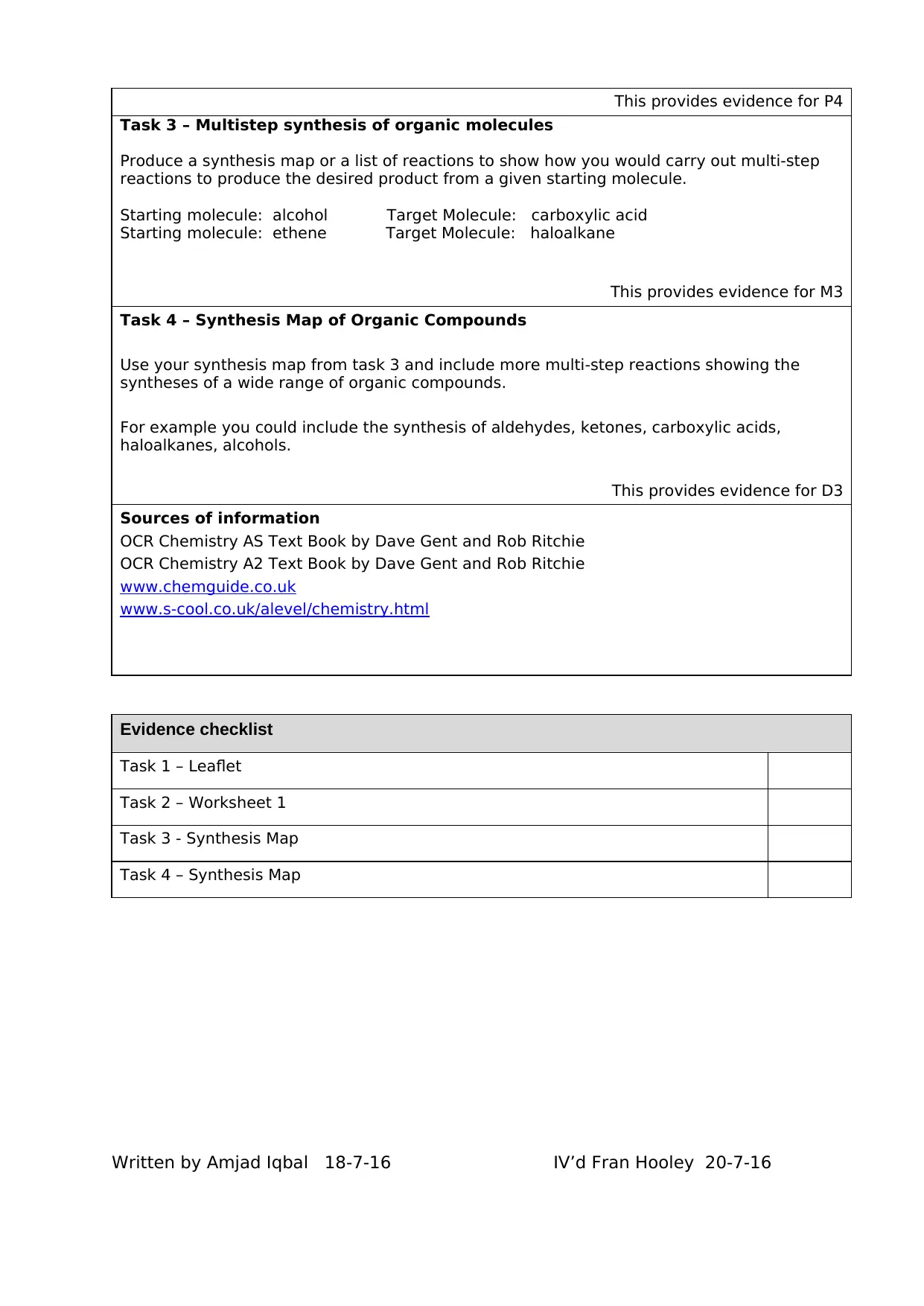
This provides evidence for P4
Task 3 – Multistep synthesis of organic molecules
Produce a synthesis map or a list of reactions to show how you would carry out multi-step
reactions to produce the desired product from a given starting molecule.
Starting molecule: alcohol Target Molecule: carboxylic acid
Starting molecule: ethene Target Molecule: haloalkane
This provides evidence for M3
Task 4 – Synthesis Map of Organic Compounds
Use your synthesis map from task 3 and include more multi-step reactions showing the
syntheses of a wide range of organic compounds.
For example you could include the synthesis of aldehydes, ketones, carboxylic acids,
haloalkanes, alcohols.
This provides evidence for D3
Sources of information
OCR Chemistry AS Text Book by Dave Gent and Rob Ritchie
OCR Chemistry A2 Text Book by Dave Gent and Rob Ritchie
www.chemguide.co.uk
www.s-cool.co.uk/alevel/chemistry.html
Evidence checklist
Task 1 – Leaflet
Task 2 – Worksheet 1
Task 3 - Synthesis Map
Task 4 – Synthesis Map
Written by Amjad Iqbal 18-7-16 IV’d Fran Hooley 20-7-16
Task 3 – Multistep synthesis of organic molecules
Produce a synthesis map or a list of reactions to show how you would carry out multi-step
reactions to produce the desired product from a given starting molecule.
Starting molecule: alcohol Target Molecule: carboxylic acid
Starting molecule: ethene Target Molecule: haloalkane
This provides evidence for M3
Task 4 – Synthesis Map of Organic Compounds
Use your synthesis map from task 3 and include more multi-step reactions showing the
syntheses of a wide range of organic compounds.
For example you could include the synthesis of aldehydes, ketones, carboxylic acids,
haloalkanes, alcohols.
This provides evidence for D3
Sources of information
OCR Chemistry AS Text Book by Dave Gent and Rob Ritchie
OCR Chemistry A2 Text Book by Dave Gent and Rob Ritchie
www.chemguide.co.uk
www.s-cool.co.uk/alevel/chemistry.html
Evidence checklist
Task 1 – Leaflet
Task 2 – Worksheet 1
Task 3 - Synthesis Map
Task 4 – Synthesis Map
Written by Amjad Iqbal 18-7-16 IV’d Fran Hooley 20-7-16
⊘ This is a preview!⊘
Do you want full access?
Subscribe today to unlock all pages.

Trusted by 1+ million students worldwide
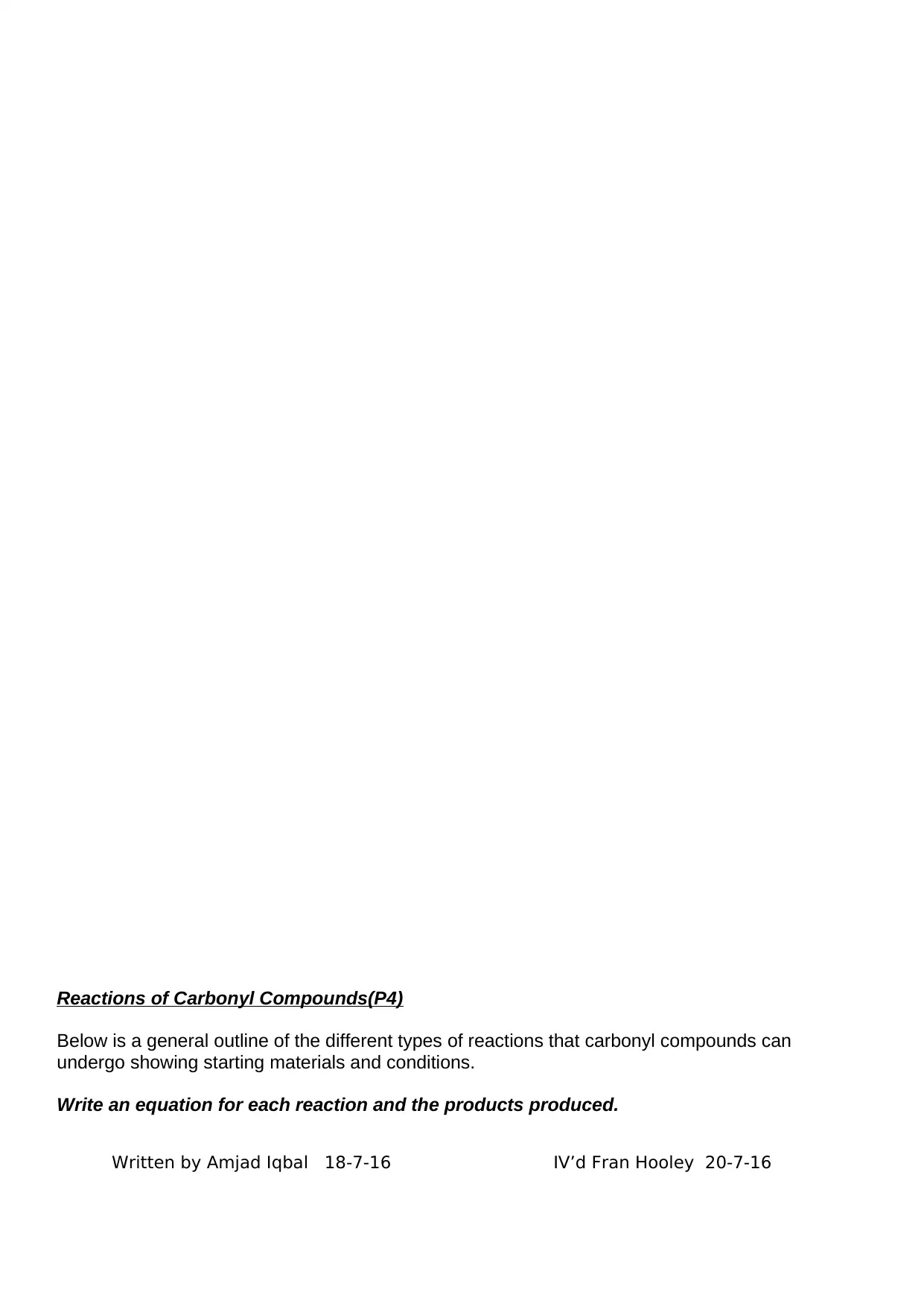
Reactions of Carbonyl Compounds(P4)
Below is a general outline of the different types of reactions that carbonyl compounds can
undergo showing starting materials and conditions.
Write an equation for each reaction and the products produced.
Written by Amjad Iqbal 18-7-16 IV’d Fran Hooley 20-7-16
Below is a general outline of the different types of reactions that carbonyl compounds can
undergo showing starting materials and conditions.
Write an equation for each reaction and the products produced.
Written by Amjad Iqbal 18-7-16 IV’d Fran Hooley 20-7-16
Paraphrase This Document
Need a fresh take? Get an instant paraphrase of this document with our AI Paraphraser
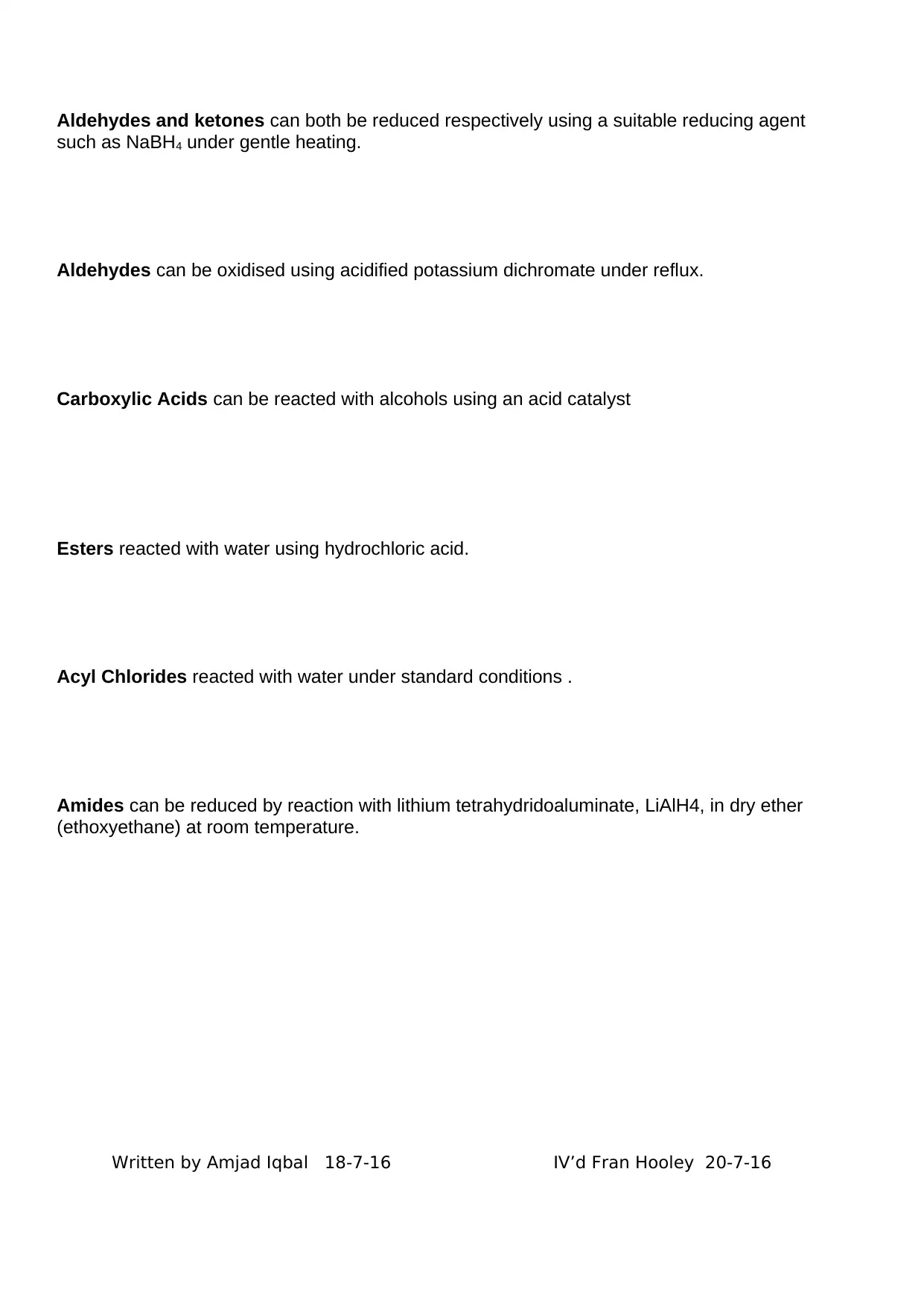
Aldehydes and ketones can both be reduced respectively using a suitable reducing agent
such as NaBH4 under gentle heating.
Aldehydes can be oxidised using acidified potassium dichromate under reflux.
Carboxylic Acids can be reacted with alcohols using an acid catalyst
Esters reacted with water using hydrochloric acid.
Acyl Chlorides reacted with water under standard conditions .
Amides can be reduced by reaction with lithium tetrahydridoaluminate, LiAlH4, in dry ether
(ethoxyethane) at room temperature.
Written by Amjad Iqbal 18-7-16 IV’d Fran Hooley 20-7-16
such as NaBH4 under gentle heating.
Aldehydes can be oxidised using acidified potassium dichromate under reflux.
Carboxylic Acids can be reacted with alcohols using an acid catalyst
Esters reacted with water using hydrochloric acid.
Acyl Chlorides reacted with water under standard conditions .
Amides can be reduced by reaction with lithium tetrahydridoaluminate, LiAlH4, in dry ether
(ethoxyethane) at room temperature.
Written by Amjad Iqbal 18-7-16 IV’d Fran Hooley 20-7-16
1 out of 5
Your All-in-One AI-Powered Toolkit for Academic Success.
+13062052269
info@desklib.com
Available 24*7 on WhatsApp / Email
![[object Object]](/_next/static/media/star-bottom.7253800d.svg)
Unlock your academic potential
Copyright © 2020–2025 A2Z Services. All Rights Reserved. Developed and managed by ZUCOL.